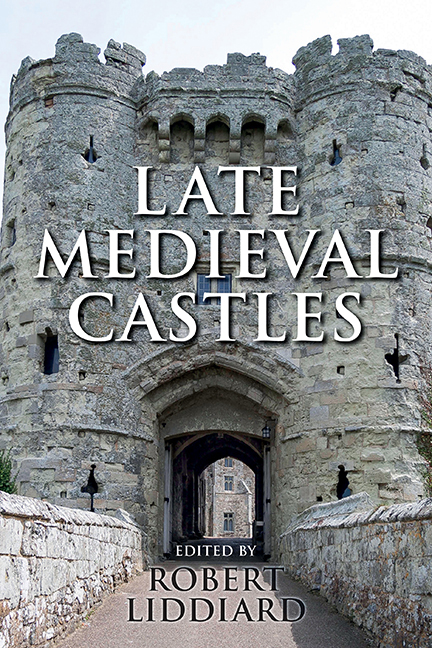Book contents
- Frontmatter
- Contents
- List of Illustrations
- Acknowledgements
- Editor's Preface
- List of Abbreviations
- A Note on the Text
- Introduction
- 1 Fourteenth-Century Castles in Context: Apotheosis or Decline?
- 2 Architects, Advisors and Design at Edward I's Castles in Wales
- 3 The Courtyard and the Tower: Contexts and Symbols in the Development of Late Medieval Great Houses
- 4 Castle Planning in the Fourteenth Century
- 5 Meaningful Constructions: Spatial and Functional Analysis of Medieval Buildings
- 6 Mota, Aula et Turris: The Manor-Houses of the Anglo-Scottish Border
- 7 Lulworth Castle, Dorset
- 8 A Scottish Problem with Castles
- 9 Structural Symbolism in Medieval Castle Architecture
- 10 Specimens of Freedom to Crenellate by Licence
- 11 Some Analysis of the Castle of Bodiam, East Sussex
- 12 English Castles in the Reign Of Edward II
- 13 Castles of Ward and the Changing Pattern of Border Conflict in Ireland
- 14 The Donjon Of Knaresborough: The Castle As Theatre
- 15 The Architecture of Arthurian Enthusiasm: Castle Symbolism in the Reigns of Edward I and his Successors
- 16 Medieval Ornamental Landscapes
- 17 Otherworld Castles in Middle English Arthurian Romance
- Guide to Further Reading
- Index
2 - Architects, Advisors and Design at Edward I's Castles in Wales
Published online by Cambridge University Press: 29 April 2017
- Frontmatter
- Contents
- List of Illustrations
- Acknowledgements
- Editor's Preface
- List of Abbreviations
- A Note on the Text
- Introduction
- 1 Fourteenth-Century Castles in Context: Apotheosis or Decline?
- 2 Architects, Advisors and Design at Edward I's Castles in Wales
- 3 The Courtyard and the Tower: Contexts and Symbols in the Development of Late Medieval Great Houses
- 4 Castle Planning in the Fourteenth Century
- 5 Meaningful Constructions: Spatial and Functional Analysis of Medieval Buildings
- 6 Mota, Aula et Turris: The Manor-Houses of the Anglo-Scottish Border
- 7 Lulworth Castle, Dorset
- 8 A Scottish Problem with Castles
- 9 Structural Symbolism in Medieval Castle Architecture
- 10 Specimens of Freedom to Crenellate by Licence
- 11 Some Analysis of the Castle of Bodiam, East Sussex
- 12 English Castles in the Reign Of Edward II
- 13 Castles of Ward and the Changing Pattern of Border Conflict in Ireland
- 14 The Donjon Of Knaresborough: The Castle As Theatre
- 15 The Architecture of Arthurian Enthusiasm: Castle Symbolism in the Reigns of Edward I and his Successors
- 16 Medieval Ornamental Landscapes
- 17 Otherworld Castles in Middle English Arthurian Romance
- Guide to Further Reading
- Index
Summary
The concentration of military architecture in North Wales from Flint in the east to Anglesey in the west is unsurpassed anywhere in Great Britain. Some of the castles are attributable to the wars fought between the princes of Wales and Edward I of England in 1277, 1282 and 1294/5. Others were built several decades earlier, by both the Welsh and the English. Of these, some were slighted and left in disrepair after Edward's conquest, but the English took over and modified some others, notably Castell-y-Bere, Criccieth and Dolwyddelan. This article is primarily concerned not with them, but with the castles built de novo around Snowdonia by Edward after his various campaigns: Flint and Rhuddlan founded from 1277, Conway, Caernarfon and Harlech from 1283, and Beaumaris from 1295. Their location reflects the outcome of the wars, with Flint and Rhuddlan founded in the east after Llywelyn ap Gruffudd had retreated into Snowdonia; Conwy, Caernarfon and Harlech closer to Snowdon after Llywelyn's defeat and death; and Beaumaris on Anglesey after the Welsh uprising of 1294/5. These castles are judged to be the apogee of military architecture in the late thirteenth century. Imposing and stylish, they represent all that was required in a fortified castle at that time: a visible, formidable presence that dominated its surroundings; defensive strength in walls, mural towers, and gatehouses equipped with multiple port-cullises and murder holes; and domestic apartments suited to the administrative and judicial duties that the constable would dispense in peacetime. The buildings seem to follow a common pattern in planning and detail, which suggests not only that their construction was centrally controlled, but that they were designed by the same architect. A. J. Taylor collected the documentary evidence of central control in The History of the King's Works in 1963; but in 195o he had already affirmed that the architect of the castles was James of St George, Master of the King's Works in Wales. Master James's presence in Wales was already known, but there was doubt whether he was a mason or an administrator. Taylor established unequivocally that he was a mason, and, further, he discovered that Master James actually came from Savoy, where he had been building castles for the counts.
- Type
- Chapter
- Information
- Late Medieval Castles , pp. 41 - 60Publisher: Boydell & BrewerPrint publication year: 2016

